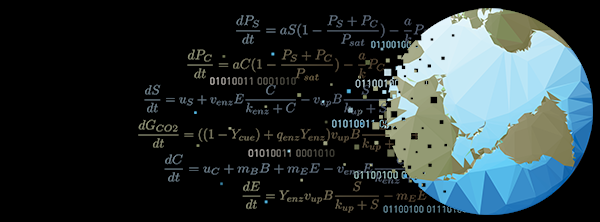Computational Biogeochemistry

The intersection between climate and the environment is particularly relevant as the world responds to anthropogenic greenhouse gas emissions, in particular CO2. Climate (or Earth system) models provide the best insights into the effects of increases in greenhouse gas on regional climate patterns. Soils play a critical role in the global carbon cycle and are important to represent in Earth system models. Specifically soils store carbon that has been fixed by plants from CO2, and then release it back to the atmosphere as CO2 when microbes eat the dead organics.
The transformation of organic carbon in the soil into atmospheric CO2 is expected to be faster under warmer and, generally, wetter climates. This has the potential to increase atmospheric carbon dioxide levels, which in turn exacerbates climate change, creating a vicious feedback. Some people have speculated that this will be balanced out by an increase in plant growth as CO2 increases but others have pointed out that plant growth is also limited by nutrients and may not respond to increases in CO2.
Mathematical and computational models can help us tease apart these effects and explore other processes that control how quickly carbon leaves the soil. How we formulate these equations reflects not only how we think soils behave now, but also how we think they will behave in the future. One of the big challenges in soil modeling right now is that we know the underlying processes in soils are often non-linear but soils seem to behave linearly as an integrated system. No one quite knows why.
As we explore these whys, we need to check our understanding against observations. All models need data, and that data is hard to come by. Despite living in an increasingly date rich world, much of the soil data that is out there is not in a form that can easily cross-talk or be integrated into models. Getting data to talk requires everyone interested in soils (researchers, land managers, and other stakeholders) to sit down and hammer out what exactly we mean when we talk about this amazing system.
Collaborations are key to both creating interesting models and connecting data. How we collaborate matters. Building and maintain collaborative teams in a research context can be tricky. Everyone comes to the table with slightly different capacities, limitations, and incentives that may or may not be apparent. There can be extreme power imbalances between junior and senior researches, especially students. Decisions are generally implied and not directly stated. While things are never going to be perfect, we can be more delibrate and thoughtful about the processes that support our collaborations.
Computational soil biogeochemistry is an amazing field of research with lots of exciting opportunities for interdicplinary work spanning biology, geology, hydrology, chemistry, informatics, mathematics, and numerous sub-discipline. My lab at the University of Florida frequently has openings for undergraduate and graduate student researchers and I’m always delighted to talk about other potential collaborations.